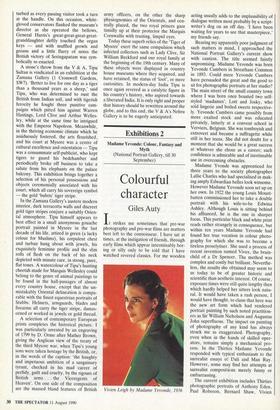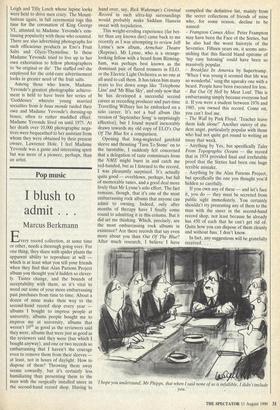Exhibitions 2
Colourful character
Giles Auty
It strikes me sometimes that pre-war photography and pre-war films are matters best left to the connoisseur. I have sat at times, at the instigation of friends, through early films which appear interminably bor- ing or silly only to be told that I have watched revered classics. For me wooden
Vivien Leigh by Madame Yevonde, 1936 acting usually adds to the implausibility of dialogue written most probably by a script- writer's dog on an off day. 'I have been waiting for years to see that masterpiece,' my friends say.
Bearing my apparently poor judgment of such matters in mind,. I approached the National Portrait Gallery's current show with caution. The title seemed faintly unpromising. Madame Yevonde was born Yevonde Cumbers in Streatham Common in 1893. Could mere Yevonde Cumbers have persuaded the great and the good to sit for photographic portraits at her studio? The main street of the small country town where I was born once boasted two self- styled 'madames', Lott and Josky, who sold lingerie and boiled sweets respective- ly. Yevonde Cumbers came possibly from more exalted stock and was educated privately, latterly at a convent school in Verviers, Belgium. She was tomboyish and extrovert and became a suffragette while still in her teens. She did not doubt for a moment that she would be a great success at whatever she chose as a career; such confidence is admirable and of inestimable use in overcoming obstacles.
Madame Yvonde was apprenticed for three years to the society photographer Lallie Charles who had specialised in mak- ing amply Edwardian belles look winsome. However Madame Yevonde soon set up on her own. In 1922 the young Louis Mount- batten commissioned her to take a double portrait with his wife-to-be Edwina Ashley. Although Louis is sitting behind his affianced, he is the one in sharper focus. This particular black and white print reads rather strangely in consequence, but within ten years Madame Yevonde had found her true vocation in colour photo- graphy for which she was to become a tireless proselytiser. She used a process of recent invention named Vivex, the brain- child of a Dr Spencer. The method was complex and costly but brilliant. Neverthe- less, the results she obtained may seem to us today to be of greater historic and scientific than aesthetic interest. Of course, exposure times were still quite lengthy then which hardly helped her sitters look natu- ral. It would have taken a rash person, I would have thought, to claim that here was the new art form which had rendered portrait painting by such noted practition- ers as Sir William Nicholson and Augustus John superfluous. The impact on painting of photography of any kind has always struck me as exaggerated. Photography, even when in the hands of skilled oper- ators, remains simply a mechanical pro- cess. In the Thirties Madame Yevonde responded with typical enthusiasm to the surrealist essays of Dali and Man Ray. However, some may find her attempts at surrealist compositions merely funny or embarrassing.
The current exhibition includes Thirties photographic portraits of Anthony Eden, Paul Robeson, Bernard Shaw, Vivien Leigh and Tilly Losch whose lupine looks were held to drive men crazy. The Mount- battens again, in full ceremonial togs this time for the coronation of King George VI, attested to Madame Yevonde's con- tinuing popularity with those who counted. There are also advertising photographs for such efficacious products as Eno's Fruit Salts and Glyco-Thymoline. In these Madame Yevonde tried to live up to her own exhortation to fellow photographers to 'be original or die'. The stuffed owl she employed for the cold-cure advertisement looks in greater need of the fruit salts.
Among those who know, Madame Yevonde's greatest photographic achieve- ment is held to have been her series of 'Goddesses' wherein young married socialites from le beau monde raided their own and Madame Yevonde's dressing-up boxes, often to rather muddled effect. Madame Yevonde lived on until 1975. At her death over 10,000 photographic nega- tives were bequeathed to her assistant from whom they were obtained by their present owner, Lawrence Hole. I feel Madame Yevonde was a game and interesting spirit but was more of a pioneer, perhaps, than an artist.











































 Previous page
Previous page